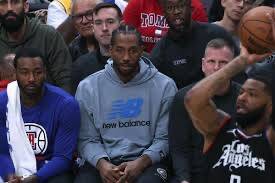
When you think of players with legendary legacies, you think of guys who battled through injuries, defied pain, and left everything on the court. Players like Kobe Bryant, who famously shot two free throws after tearing his Achilles. Or Steve Nash, who broke his nose in a playoff game against the Spurs and had to be physically pulled out because he refused to sit, despite bleeding all over the floor.
Those moments are seared into our memory because they represent something larger than stats — they represent sacrifice, grit, and love for the game. But today, the conversation around legacy is shifting. Increasingly, people are factoring in availability when judging a player’s greatness. And players like Kawhi Leonard and Joel Embiid, despite their undeniable dominance when they’re on the floor, face constant criticism for how often they’re not.
So what’s the reason?
Well, the main one is something we hear constantly now: Load Management.
What is Load Management, Really?
Load management is the practice of teams resting star players throughout the season to reduce physical and mental strain, with the goal of having them fully healthy and ready for the playoffs. It became more noticeable in the early 2010s, but it's exploded in recent years.
Just two years ago, only 11 players in the entire NBA played all 82 games. This past season? Five. Out of roughly 550 active NBA players, only five managed to go wire-to-wire. That’s kind of insane — and for many fans, deeply frustrating.
While the logic behind load management is rooted in medical science and long-term performance, it often feels like it clashes with the emotional and competitive spirit of basketball. Watching your favorite player sit during a nationally televised game — or worse, a rare trip to your city — feels like a betrayal to some fans.
The NBA's Response.
To combat the rise of load management, the NBA introduced new rules. Most notably, a player must now appear in at least 65 games to be eligible for end-of-season awards like MVP, Defensive Player of the Year, and All-NBA honors.
It’s already made an impact. Take Shai Gilgeous-Alexander for example — this year’s MVP. He played 76 games, led the Thunder to the NBA Finals, and checked all the boxes the league wants in a face of the franchise.
But the rule isn’t perfect. Look at Joel Embiid. In his MVP season, he only played 66 games, barely clearing the threshold. Yet no one denies how dominant he was — arguably one of the most physically overwhelming centers the game has ever seen. He might not be on the court every night, but when he is, he changes the game entirely.
What should Legacy really mean?
n my opinion, legacy should be defined by what you do when you're on the court. We joke about Embiid and Kawhi being “part-time stars,” but when they're healthy, they're not just good — they’re elite. They’re game-changers.
Sure, you’d like to see them more often. But in the playoffs? You need them.
It’s also worth recognizing that today’s NBA players are stronger, faster, and more skilled than any era before. The game is more demanding than ever — every possession is faster-paced, more physical, and more competitive. So, it's understandable that bodies break down faster. But on the flip side, medical science and recovery technology have also advanced dramatically. With better trainers, nutrition, and rehab, shouldn't players be able to handle more?
The Bottom Line.
Load management, in theory, makes sense. These athletes aren’t just entertainers — they’re human beings. They deserve time to recover mentally and physically. But when you're getting paid $15–50 million a year and you’re labeled as the franchise player, there's a level of responsibility that comes with that. You're expected to lead, to show up, and yes — to play.
If a player wants to build a legacy in the NBA, it can’t just be about numbers or highlight reels. It’s about availability and making winning your obligation, not your option
Landon Neilson
2025
Add comment
Comments